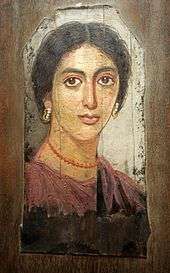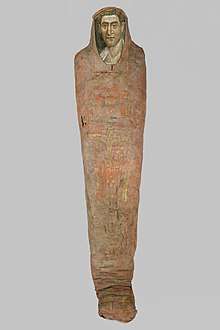Encaustic painting
Encaustic painting, also known as hot wax painting, involves using heated beeswax to which colored pigments are added. The liquid or paste is then applied to a surface—usually prepared wood, though canvas and other materials are often used. The simplest encaustic mixture can be made from adding pigments to beeswax, but there are several other recipes that can be used—some containing other types of waxes, damar resin, linseed oil, or other ingredients. Pure, powdered pigments can be used, though some mixtures use oil paints or other forms of pigment.[1]

Metal tools and special brushes can be used to shape the paint before it cools, or heated metal tools can be used to manipulate the wax once it has cooled onto the surface. Today, tools such as heat lamps, heat guns, and other methods of applying heat allow artists to extend the amount of time they have to work with the material. Because wax is used as the pigment binder, encaustics can be sculpted as well as painted. Other materials can be encased or collaged into the surface, or layered, using the encaustic medium to stick them to the surface.
A completely unrelated type of "encaustic painting", not involving wax at all, is found in British ceramics, after Josiah Wedgwood devised and patented the technique in 1769. This was a mixture of ceramic slip and overglaze "enamel" paints used to imitate ancient Greek vase painting, and given a light second firing. Usually the vessel was black and painted in the red of red-figure painting. The technique was copied by other British potteries.[2] Encaustic tiles are not painted at all, but effectively inlaid with contrasting colours of clay for a polychrome pattern.
History

The word encaustic originates from the Greek word enkaustikos[3] which means to burn in, and this element of heat is necessary for a painting to be called encaustic.
The wax encaustic painting technique was described by the Roman scholar Pliny the Elder in his Natural History from the 1st Century AD.[4] The oldest surviving encaustic panel paintings are the Romano-Egyptian Fayum mummy portraits from Egypt around 100–300 AD,[5] but was a very common technique in ancient Greek and Roman painting. It continued to be used in early Byzantine icons but was effectively abandoned in the Western Church.
Kut-kut, a lost art of the Philippines, employs sgraffito and encaustic techniques. It was practiced by the indigenous tribe of Samar island around 1600 to 1800.[6] Artists in the Mexican muralism movement, such as Diego Rivera[7] and Jean Charlot[8] sometimes used encaustic painting. The Belgian artist James Ensor also experimented with encaustic.[9]

In the 20th century, painter Fritz Faiss (1905–1981), a student of Paul Klee and Wassily Kandinsky at the Bauhaus, together with Dr. Hans Schmid, rediscovered the so-called "Punic wax" technique of encaustic painting. Faiss held two German patents related to the preparation of waxes for encaustic painting. One covered a method for treating beeswax so that its melting point was raised from 60 to 100 °C (140 to 212 °F). This occurred after boiling the wax in a solution of sea water and soda three successive times. The resulting harder wax is the same as the Punic wax referred to in ancient Greek writings on encaustic painting.[10][11] Other 20th-century North American artists, including Jasper Johns, Tony Scherman, Mark Perlman, and Fernando Leal Audirac have used encaustic techniques.
Encaustic art has seen a resurgence in popularity since the 1990s with people using electric irons, hotplates and heated styli on different surfaces including card, paper and even pottery. The iron makes producing a variety of artistic patterns easier. The medium is not limited to just simple designs; it can be used to create complex paintings, just as in other media such as oil and acrylic.[12] Although technically difficult to master, attractions of this medium for contemporary artists are its dimensional quality and luminous color.[13]
Encaustic painters
Artists specializing in encaustic painting include the following:
See also
Notes
- "What Is Encaustic?". Encaustic Art Institute.
- Young, 51; "Bulb pot and cover", V&A Museum
- "Encaustic", The Oxford American Dictionary
- Pliny the Elder 1885, Book 35, ch 41.
- Doxiadis 1995, p. 193.
- "Pinoy artist promotes native art in Chicago". ABS-CBN News. 5 March 2008. Retrieved 2016-06-09.
- "Painting: Encaustic". Archived from the original on May 13, 2011. Retrieved 2011-05-13.CS1 maint: BOT: original-url status unknown (link)
- Charlot 1998.
- "Fireworks", 1887, James Ensor (see "James Ensor" MoMA, New York, 2009)
- Reams, Maxine (October 19, 1952). "Unique Wax Paintings by Immigrant Artist Should Endure 10,000 Years". Los Angeles Times. G14.CS1 maint: location (link)
- "Fritz Faiss Encaustic Work Shown". Los Angeles Times. D6. February 3, 1952.CS1 maint: location (link)
- Mayer, Ralph. "Encaustic Painting - Ralph Mayer". www.abstract-art.com. Retrieved 21 October 2016.
- Gianquinto, Michael A., Cape Cod Museum Curator of Art. Swept Away: Translucense, Transparence, Transcendence in Contemporary Encaustic. (2014) Curator's foreword to Hunterdon Art Museum Exhibition Catalog,p. 6.
References
- Doxiadis, Euphrosyne (1995). The Mysterious Fayum Portraits: Faces from Ancient Egypt. H. N. Abrams. ISBN 978-0-500-28217-5.CS1 maint: ref=harv (link)
- Charlot, John (February 16–20, 1998). El Primer Fresco de Jean Charlot: La Masacre en el Templo Mayor [Jean Charlot's First Fresco:The Massacre in the Main Temple]. Congreso Internacional de Muralismo: San Ildefonso cuna del muralismo mexicano, Reflexiones historiográficas y artísticas (in Spanish). Mexico City.CS1 maint: ref=harv (link)
- Pliny the Elder (1855) [c. AD70]. The Natural History. Translated by John Bostock; H.T. Riley. London: Taylor and Francis.CS1 maint: ref=harv (link)
- Young, Hilary (ed.), The Genius of Wedgwood (exhibition catalogue), 1995, Victoria and Albert Museum, ISBN 185177159X
Further reading
- Mayer, Ralph; Sheehan, Steven (1991). The Artist's Handbook of Materials and Techniques. Viking. ISBN 978-0-670-83701-4.CS1 maint: ref=harv (link)
- Reams, Maxine. "Unique Wax Paintings by Immigrant Artist should Endure 10,000 Years." Los Angeles Times, Oct. 19, 1952
- Birgit Hüttemann-Holz (2013). Wanderlust. Gedichte und Malerei in Enkaustik - poems and encaustic paintings. San Francisko, USA: Blurb Inc.
- Hildebrandt, Hans. "Fritz Faiss" Kunst der Nation, 1933
- Mattera, Joanne (2001). The Art of Encaustic Painting: Contemporary Expression in the Ancient Medium of Pigmented Wax. Watson-Guptill Publications. p. 22. ISBN 978-0-8230-0283-2.CS1 maint: ref=harv (link)
- Rankin, Lissa (2010). Encaustic Art: The Complete Guide to Creating Fine Art with Wax. Watson-Guptill Publications. ISBN 978-0-8230-9928-3.CS1 maint: ref=harv (link)
- Gottsegen, Mark David (2006). Painter's Handbook: Revised and Expanded (Revised, Expanded ed.). New York: Watson-Guptill. p. 60. ISBN 978-0-8230-3496-3.
External links
| Wikimedia Commons has media related to Encaustic painting. |